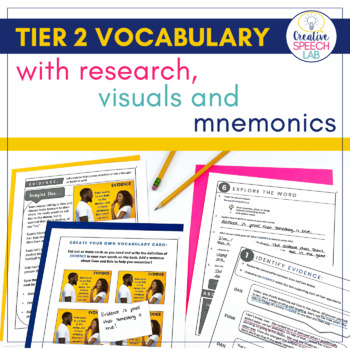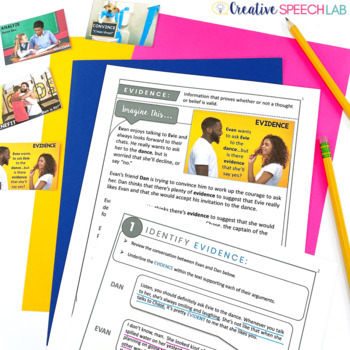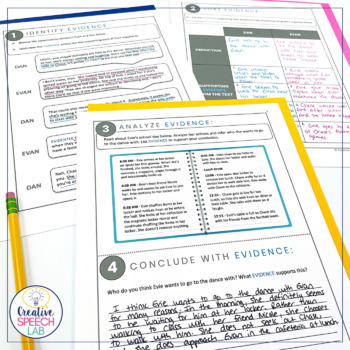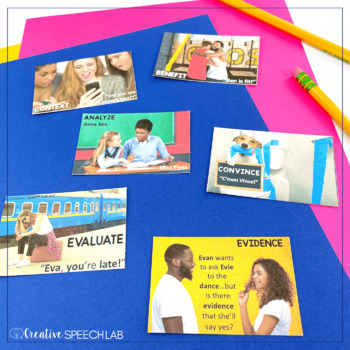Tier 2 Vocabulary Intervention with Research, Visuals & Mnemonics
- PDF
- Easel Activity
What educators are saying
Description
It can feel overwhelming to implement evidence-based vocabulary instruction while trying to engage your older students. These Tier 2 vocabulary activities incorporate research principles gathered from over 20 academic journal articles and textbooks to help your students understand and remember the vocabulary needed to succeed in the classroom. All 21 vocabulary units include real photographs, engaging mnemonics, relatable narratives, graphic organizers and no prep activities that are sure to engage your older caseload!
Tier 2 Vocabulary is recommended by researchers because it occurs across the academic curriculum (e.g. ”evaluate”)(Elleman et al., 2019). Each Tier 2 word in this comprehensive packet is versatile, cross-curricular and visually-supported through the use of real photographs.
This Common Core-aligned resource includes an introductory section for educators, which contains the following:
- Introduction with an overview of the key features in this resource
- Research-Based Vocabulary Intervention Tips Handout
- Detailed description of how evidence obtained from peer-reviewed academic journal articles informed the creation of this resource.
- References section listing all of the research implemented
The second section for students is comprised of 21 comprehensive Tier 2 Vocabulary Units, which include:
- Mnemonics, which link the phonological and semantic components of each word, (making them especially memorable for your students!)
- Real photographs and fictional narratives corresponding to each mnemonic
- Interactive, research-based activities linked to the narratives
- Graphic Organizers
- Word Association Activities
- True/False Questions
- Wide-range of language activities
The research principles incorporated in this resource include:
- Use of Tier 2 Vocabulary (Elleman et al., 2019)
- Attention to morphology, root words and affixes (Elleman et al., 2019)
- Phonological-semantic cues (Lowe et al., 2017)
- Multiple contexts (Elleman et al., 2019)
- Engaging vocabulary activities (Wright & Cervetti., 2016)
- 8-20 exposures of the target word in context (Elleman et al., 2019)
- Graphic organizers (Elleman et al., 2019)
- High-quality discussions (Elleman et al., 2019)
- Teaching words in relation to other words in context (Elleman et al., 2019)
- Semantic mapping (Dixon et al., 2020)
- Kid-friendly definitions and cards (Dixon et al., 2020)
- Real-life connections (Spencer et al., 2017)
- Using words in sentences (Spencer et al., 2017)
Skills targeted include:
- Receptive vocabulary
- Expressive Vocabulary
- WH Questions
- Reading Comprehension
- Oral Language
- Written Language
- Critical Thinking
- Deductive Reasoning
- Summarizing and story retell
- Inferencing
- Synonyms/Antonyms
- Word Associations
- Comparing and contrasting
- Inferencing
- Multiple-Meaning Words
- Morphology
Tier 2 Vocabulary included:
- Analyze
- Benefit
- Conclude
- Context
- Convince
- Determine
- Edit
- Eliminate
- Evaluate
- Evidence
- Explain
- Identify
- Indicate
- Interject
- Interrogate
- Mandatory
- Presume
- React
- Specific
- Summary
- Verify
In addition to this low-ink printable version, you’ll also receive access to a digital version through TpT Easel.
This packet can easily be used in individual, small group or whole class lessons.
If you enjoy using this resource with your students, please consider leaving feedback on your purchase (which will earn you credits for future purchases!) The time you take to leave a rating is greatly appreciated!
References:
Dixon, C., Thomson, J., & Fricke, S. (2020). Evaluation of an explicit vocabulary teaching intervention for children learning English as an additional language in primary school. Child Language Teaching and Therapy, 36(2), 91–108.
Elleman, A. M., Oslund, E. L., Griffin, N. M., & Myers, K. E. (2019). A Review of Middle School Vocabulary Interventions: Five Research-Based Recommendations for Practice. Language, Speech, and Hearing Services in Schools, 50(4), 477–492. https://doi.org/10.1044/2019_lshss-voia-18-0145
Lowe, H., Henry, L., Müller, L., & Joffe, V. L. (2017). Vocabulary intervention for adolescents with language disorder: a systematic review. International Journal of Language & Communication Disorders, 53(2), 199–217.
Spencer, S., Clegg, J., Lowe, H., & Stackhouse, J. (2017). Increasing adolescents’ depth of understanding of cross-curriculum words: an intervention study. International Journal of Language & Communication Disorders, 52(5), 652–668.
Wright, T.S., & Cervetti, G.N. (2016). A systematic review of the research on vocabulary instruction that impacts text comprehension. Reading Research Quarterly, 52(2), 203-226.






